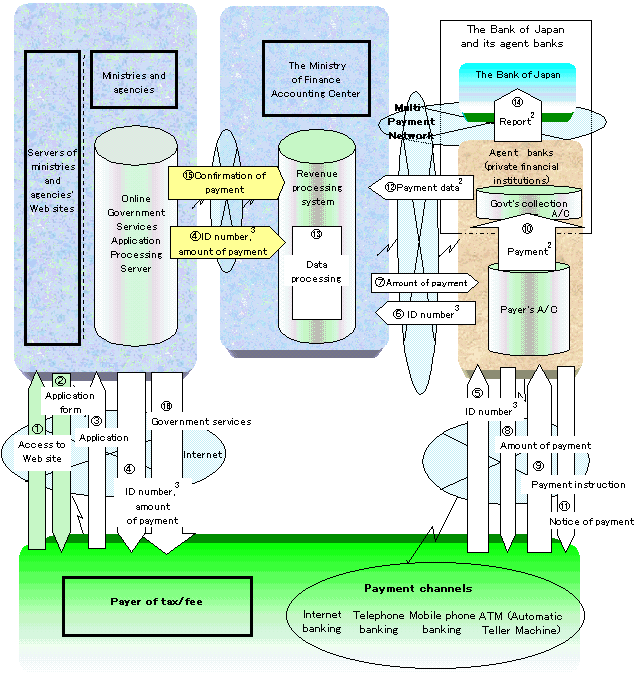A New Scheme for Electronic Payment of Government Taxes and Fees
November 2, 2001
Bank of Japan
The Bank of Japan1 hereby introduces a scheme for electronic payment of taxes and fees to the government which it plans to make available by the end of March 2004.The Bank has two objectives: to enhance payers' convenience and to streamline the operations at banks, in government offices, and in the Bank itself.The Bank examined various electronic methods for the new scheme in cooperation with related institutions, and has selected the "Multi-Payment Network" system which is now being developed by the banking industry in Japan.The network is designed to enable bank customers to pay electronically every kind of bills including utility, telephone, and credit card charges as well as local government taxes.The pilot stage of the network started last month.
- nder the Bank of Japan Law and the Public Accounting Law, the Bank of Japan handles the government's funds.
1. Merits for Payers
Tax/fee payers will be able to make electronic payments to the government without going to a bank by logging into electronic banking services via PCs, mobile phones, and other means. They will be able to pay from virtually anywhere and at any time of the day or night, and even on bank holidays when the banks are closed.
Banks' Automated Teller Machines (ATMs) will be another means for the electronic payment scheme.Using the 24-hour ATMs which are now becoming more widely available, non-PC users too will be able to pay even in the middle of the night.2
An example of electronic payment would be as follows (see Appendix):3
- (a) An individual who requires an online government service4 first accesses the Web site of the ministries and agencies.
- (b) He or she obtains two unique numbers, i.e., the Identification Number and the Confirmation Number5 from the Web site.
- (c) To pay for such services, the payer sends these two numbers from his/her Internet banking terminal to his/her bank.
- (d) The bank transfers them to the government through the "Multi-Payment Network."6
- (e) The government sends billing information back to the bank through the "Multi-Payment Network."
- (f) The bank transfers the information to the payer's terminal.
- (g) The payer then sends a payment instruction with a single "click" on the screen.
- (h) Upon receiving this instruction, the bank debits the payer's account.
- (i) The bank then credits its collection account and sends a collection record to the government as well as to the Bank of Japan.
- (j) The bank sends a notice of payment to the payer's terminal.
- 2To participate in the scheme and to offer new electronic banking services to their customers, banks need to upgrade their systems.
- 3The message exchanges in (c)-(j) are processed within a few seconds.The payer uses his/her keyboard only in (a), (c), and (g).
- 4Under the "e-Japan Strategy," published by the Japanese government in January 2001, online government services will be widely available by the end of the fiscal year 2003.
- 5This dual numbering reduces the risk of intentional reading of others' billing information.This also eliminates the possibilities of unintentional payment of others' bill as a result of mistyping.
- 6The participating banks' networks and the "Multi-Payment Network" enable online, real-time, and interactive message exchanges between payers and payee institutions.
2. Electronic Processing at the Bank of Japan's Agent Banks
Receiving the payment and reporting to both the government and the Bank are the business of the agent banks entrusted to them by the Bank.Hitherto, they have been paper-based and the Bank intends to shift them from paper to electronic processing.
In the plan, in (i) above the banks operate as agent banks of the Bank of Japan.
3. The "Multi-Payment Network"
(1) Rationales for the "Multi-Payment Network"
- (a) Cost minimization
As noted above, the "Multi-Payment Network" is being designed for various bill payments, and using the same network with the standardized procedures for the collection of government taxes and fees would produce a cost sharing benefit.In other words, the Bank's share of the cost of building and maintaining the network would be much less than that of a single-payment network built and used only by the Bank.This cost saving would be to the taxpayer's benefit. - (b) Security
Special consideration has been given to the security of the "Multi-Payment Network" to prevent, detect, and reduce potential risks.An external specialized institution has assessed the network's security management framework as adequate at this stage. - (c) Reliability of the network management
Japan Multi-Payment Network Management Organization (JAMMO) runs the network.It is a banking industry-wide organization, many of whose members are agent banks of the Bank of Japan, and thus the Bank has confidence in JAMMO's network management.
(2) Requirements to be met
The Bank of Japan considers the following are requirements for using the "Multi-Payment Network."
- (a) The existing services of the "Multi-Payment Network" such as telephone bill payment are operated safely and smoothly.
- (b) Appropriate contracts are prepared by the institutions involved, and necessary legislation has been established.
- (c) The cost is fairly allocated among the related institutions.
Appendix


